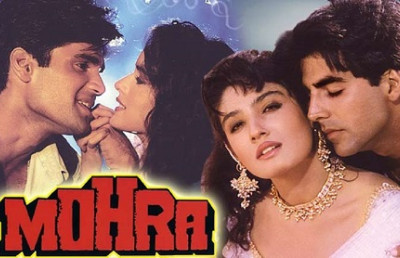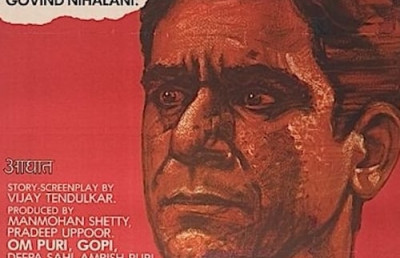Govind Nihalani’s Aghaat (1985), the Workers’ Struggle, and the Failures of Indira Gandhi’s Congress Party Socialism
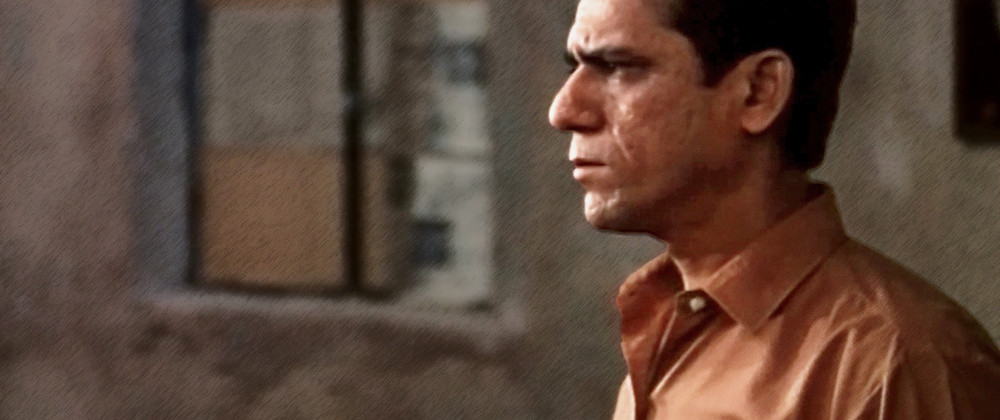
Aghaat (Photo source, Neo Films Association)
In the introduction to her book Art Cinema and India’s Forgotten Futures: Film and History in the Postcolony, Rochona Majumdar speaks of (Indian) art cinema as a mode of doing history. She notes that art films “became histories of their present that, in their steadfast commitment to capturing the contemporary in all its unresolvable contradictions, point toward possible, unrealized futures.” 1 Majumdar’s book focuses on the works of Indian filmmakers Satyajit Ray, Mrinal Sen, and Ritwik Ghatak, albeit in the context of her proposition regarding art cinema as a mode of exploring possible futures. She asks what can films, as historical documents, as imaginations of a place and time, tell us? What futures can they point to? Following these questions, it becomes crucial to seek films that did not simply imagine the early postcolonial nation as a utopia, but “captured the contemporary,” a nation overrun with unemployment, corruption, and urbanization.
Defying stringent categorization, which in any case often forecloses the possibility of meaningful analysis, the Indian filmmaker Govind Nihalani has been known for including elements of both “art” and “popular” cinema. John W. Hood notes that “his (Nihalani’s) films are among the most entertaining of Indian art cinema as well as being widely admired for their technical excellence.” 2 Hood’s choice of words (Nihalani’s films as the most entertaining examples of art cinema) expresses a resistance to any classification mechanism, that Nihalani’s sharp perceptiveness is transfigured into a carefully constructed realism that unfolds like a document suffused with its own moment. Govind Nihalani’s work, more specifically his brilliant, yet often overlooked, film Aghaat (1985), with a screenplay by playwright Vijay Tendulkar, follows the feud between Madhav Verma (Om Puri), the representative of an established union, and Rustom Patel (Naseeruddin Shah), leader of an opportunist faction which is being used by their employer (Shivalik Engineering) to institute a policy of automation, retrenchment, and dispossession of the factory’s workers. Aghaat was released a year after Indira Gandhi’s lengthy tenure as Prime Minister came to an end with her assassination. As such, it is a response to her Congress Party’s version of “socialism” in general, and her anti-working class policies in particular.
Aghaat, a film depicting the decline of unions, subtly offers a gradual progression in its character arcs, manipulation of iconography in its spaces, and a lack of moral polarity in its subjects. The film begins with a performance, depicting the workers’ struggle against the dual-synced enemy of state and capital as part of the Labour Day celebrations organized by Verma’s union for the employees of Shivalik Engineering. One cannot help but be reminded of Marx’s famous dictum as the workers grapple with their chains, limbs outstretched, in orchestrated motion. The performance concludes with a call to the nation’s youth to unite and fight for freedom, as the workers triumph over the supine bodies of capitalists, law enforcement personnel, and other bureaucratic elements. These opening credits are crucial, as they foreground workers’ unity, which is transformed and, to some extent, lost by the end of the film.
In a brilliant directorial choice, Nihalani doesn’t pit the “good” union against the “bad” union without quickly inserting a plot point which offers a possible resolution. Right at the beginning, as the Labour Day performance ends, the camera captures the audience, where some workers are not applauding, and are instead looking about suspiciously. As this scene follows the performance, the immediately creates an awareness of lost unity.
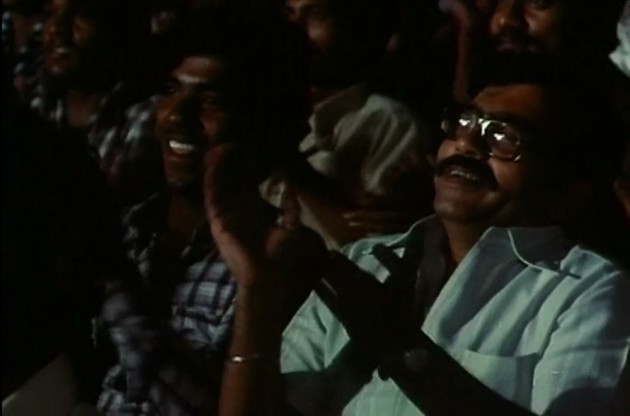
Workers applaud pro-union play, 0:04:46 (Photo source, Neo Films Association)
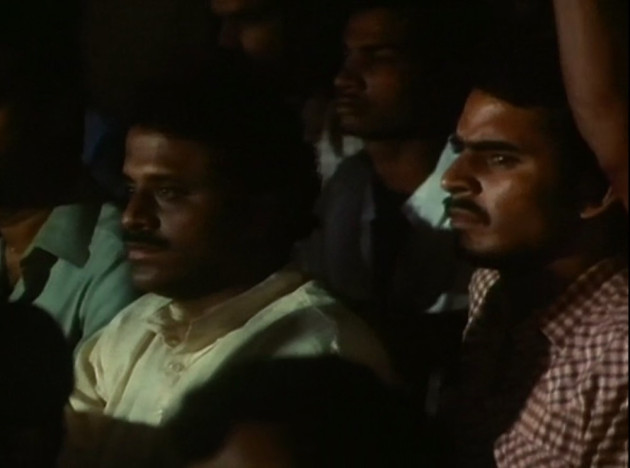
Dissident union workers react differently, 0:04:50 (Photo source, Neo Films Association)
Film Scholar Ravi Vasudevan has noted the singularity of Nihalani’s work, writing: “Art cinema . . . has by and large left this subject [popular and subaltern crime] alone, with the exception of Govind Nihalani (Ardh Satya [Half-Truth], 1983; and Aghaat [The Shock], 1985.” 3 However, the film deliberately stands against the historical backdrop of industrial relations during Congress Party socialism. By virtue of making a film like Aghaat at that time and in that place, it unavoidably references the corrupt and vapid policies of Gandhi and her corporate allies. As Indian trade union leader B.T. Ranadive has noted, inter-union conflicts can arise, but “these generally occur when the government and management sign anti-working class agreements with servile union leaders behind the back of the workers, bypassing the genuine representative organizations.” 4
In an early sequence, the factory is shown in all its massiveness. A sense of dread hangs over these shots, following on the feeling of workers’ disunity already created. In the scene that introduces us to the factory, the camera remains still as an overhead crane moves from one side of the frame to the other, throwing meager light into the space. In the following sequences, we glimpse a surface grinder as it moves back and forth, miniscule bits of metal blending quickly with the air, a limb working a wheel, buttons pressed in the machining center. These shots are accompanied by a constant whirring sound, and if senses can inform one another, they feel pungent. It is a space of workers’ mobility within the larger oppressive setting. This focus is characteristic of New Cinema, which was a “long-gestating, aesthetic propensity nourished by the FFC project 5 and coming into its own with the entry of private finance.” 6 This may be the reason why several films from the New/parallel cinema movement no longer had to ascribe to the narrative developmental realism favored by the state. What we perceive in these sequences is not the grandeur of the factory, but a communion of the workers with the machines that is mundane, an inextricable imprint of the worker as the materiality of the metal is transformed. Barring one, all shots follow the limbs, fingers, eyes of workers closely. The one shot where we can somewhat discern the substantiality of the factory is of an overhead crane that swiftly moves into a close-up similar to the other shots.
In a scene framing one of the film’s central narratives, a worker, Chote Lal (Pankaj Kapur), climbs a ladder. Midway through, he shakes it, as if to locate a problem, but then continues to move upward as the scene cuts to another worker at his machine. We don’t think much of this, because it isn’t bestowed with any quality that should set it apart from the generality of the factory sequence. It is only several minutes later that it becomes clear the ladder was faulty and the worker is now seriously injured. Before this happens, there is a conversation between a group of workers from Verma’s union with those who have left and joined Rustom’s. The dissidents claim Verma is not radical enough, while Verma’s comrades plead with them to stay and raise their complaints instead of breaking up the union. With the fall, the film cuts to workers from both factions running towards Chote Lal, signaling that the split is still nascent, the mass of workers still undivided. Showing them running to help their injured comrade also reveals an active body of workers, as opposed to an inert lump of people, by staging a chaotic movement of the active bodies of the workers without showing their faces. Throughout, the film emphasizes that the workers themselves are the protagonists.
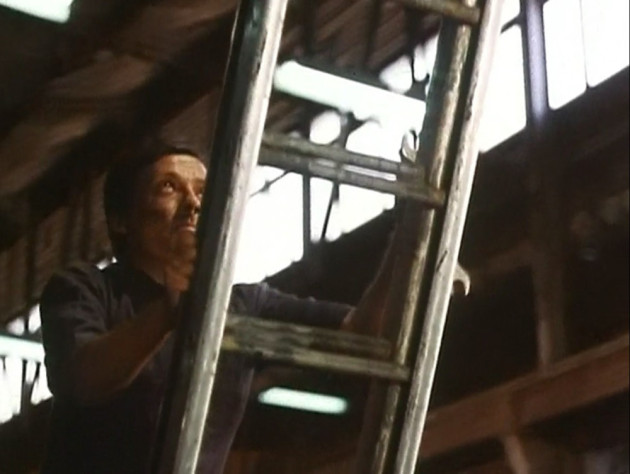
Chote Lal climbs a faulty ladder, 0:12:39 (Photo source, Neo Films Association)
Nihalani also uses sound to mark the discord between the factory floor and upper management offices. The factory sequences are always accompanied by the insistent buzzing of heavy machinery, and at times cut directly to sequestered offices, where the dialogue, although never inaudible in the factory sequences, is clearer. This is what makes a later shot, lasting just a couple of seconds, of a silent factory wordlessly signaling that the workers are on strike, so effective. This sonic discordance between the two spaces not only distinguishes between social locations, but also comments on the sensory oppression of the proletariat. Placing these sequences consecutively creates a disharmony in the audience that mirrors the onscreen action. We are able to locate certain connections, lack of connections, absences, sounds, and their different emphases precisely due to this deliberate contrast. This effect is similar to that described by Jacques Ranciere’s idea of a dissensus – the sequences “stage a conflict between two regimes of sense, two sensory worlds.” 7
In a later scene, the company’s upper management discuss the merits of Verma’s and Rustom’s factions. One of the managers remarks: “Nobody can say who will win . . . Marxist unions are becoming weaker everyday.” This reflects the film’s 1980s setting, a period in which prominent union leaders had been arrested and, more generally, trade unions were in disarray because of the clamp down on labour that had begun during the emergency period (1975-1977). As Ashok Bhargava and Gopalan Balachandran write about this period where Indira Gandhi’s government temporarily suspended democracy and many constitutional liberties: “In the labor sphere, [the] government imposed measures to maintain strong control over labor. In effect these measures made labor unrest initiated by organized labor almost impossible; similar constraint was not placed on lock-outs, shutdowns and lay-offs by capitalists. Labor wages and bonuses were also controlled.” 8 This scene in particular, and the film in general, can be viewed as a response to the ruthless anti-worker policies of Indira Gandhi’s Congress Party.
The film is deliberately paced, with tender moments scattered throughout that speak to the varied characters and elements caught up in worker-management struggles. There is the opportunist faction of Rustom Patel (whom we never see until the end of the film, but is throughout a looming presence), but there are others, such as Mr. Paranjpe (K. K. Raina), whose intentions to help the workers are genuine, but he is tangled in his own web of class interests and faith in redundant reformism. His discontent and diffidence punctuates the film in the form of nocturnal diary entries, adding layers of complexity to his character, particularly in contrast to the role he plays as the factory’s personnel manager and defender of the company’s management.
The workers are frequently seen looking up to Verma and Rustom as leaders. However, Verma is shown visiting the home of Chakradev (Amrish Puri), a mentor of sorts who shows him the way when he is most discouraged and contemplating giving up his union work. There is no similar scene involving Rustom, whose presence in the film is marked by his absence. A few workers join Rustom’s faction on fragile promises of high bonuses and higher pay – at the cost of some of their fellow workers, but this is not a fact they are privy to, their allegiance to the opportunist union shown as not being an act of malice, but the result of an undeveloped class consciousness. The need for class consciousness is repeatedly asserted by Madhav Verma, although often in throwaway comments. For example, in an early scene, Chote Lal’s brother is flattered that Mr. Paranipe visits the hospital to see Chote following the accident, but Verma calmly points out this is exactly what Paranjpe is paid for. At the same time, Verma’s status as a respected leader is reinforced several times. When Chote Lal wakes up following the accident, Verma is there to reassure him. The camera moves to Chote Lal’s wife, who acknowledges this exchange with a grateful smile, and then to Chote Lal on the bed, who also smiles as best he can. It is a moment that expresses the weight Verma carries with the union members who elected him. In a later scene, where Mrs. Ali, the social worker employed by the company, attempts a similar gesture, her smile at Chote Lal’s wife receives a muted, even indignant, response. This is not because Mrs. Ali, again, is particularly malicious. She is shown caring for the workers while simultaneously managing familial troubles. However, as part of Shivalik Engineering’s middle management, she is placed in opposition to the workers. She is later forced to sign a false statement by her employers, pointing to her own dispensability. These sequences foreground a pathetic system rather than casting blame at specific characters who are also powerless cogs in the capitalist engine.

Verma encourages the injured Chote Lal, 0:30:31 (Photo source, Neo Films Association)

Chote Lal’s wife acknowledges Verma’s compassion, 0:30:28 (Photo source, Neo Films Association)

Chote Lal, bedridden and aphasiac, responds to Verma, 0:30:35 (Photo source, Neo Films Association)
For a large part of the film, the focus is shared between the two unions mobilizing outside Shivalik’s headquarters. Both at times weaponize the case of Chote Lal and one up each other repeatedly. In a poignant scene towards the end, a memorial held for Chote Lal – who has succumbed to his injuries – turns into a confrontation, his death and its injustice forgotten. Another issue taken up by Verma’s union is automization and fear of a subsequent loss of jobs. It is useful to place this within the framework of an industrial programme that was submitted to the Lok Sabha (Indian parliament) in 1976. It set a target for a boost to export units in the engineering industry to increase capacity by 25%. 9 The following scene, where the Shivalik industrialists approach the government to intervene in the union feud, is marked with iconography related to Indira Gandhi. This specifically locates the film in 1984, her last year as Prime Minister, suggesting that the proposed regressive policies would be in keeping with the government’s anti-worker policies.

Shivalik higher ups meet with a government representative. The walls are lined with images of the corrupt Prime Minister, Indira Gandhi, 1:26:25 (Photo source, Neo Films Association)
Many spaces within the film are punctuated with iconography that helps capture the hybridity within the national imaginary. Beyond Indira Gandhi’s portrait in the minister’s office, there is also Lenin at the union office, social reformer and political leader B.R. Ambedkar at the hospital, and a large Che Guevara poster at Verma’s home. These images are more than objects that signify political beliefs. They are at once material things, but also ineffable presences which mark concurrent associations and ideological affiliations in both the city’s private and public spaces.

Union office, with Lenin on the wall, 1:02:31 (Photo source, Neo Films Association)

Verma’s home, with Che Guevara poster, 2:00:12 (Photo source, Neo Films Association)
While watching this film and writing this piece, I was also going through old newspapers my grandfather had kept conscientiously, as an archive of sorts. I was specifically fascinated by the Letters to the Editor sections of these newspapers from the 1970s and ‘80s, and a friend jokingly remarked that this was the Twitter of back-in-the-day. I should make it clear that I was limited to a few newspapers and clippings, all of them in English, so it should make it slightly easier to figure out what stratum of people were writing these letters. If not wealthy, they were certainly at least middle class and English-educated. The content of the letters varied, but I was able to spot characteristic petit bourgeois concerns such as the ”inconvenience” that protests cause to public life and the use of empty signifiers such as ”corruption” without any systemic analysis. I was instantly reminded of how, in the film, Shivalik uses newspapers to present an altruistic public image.
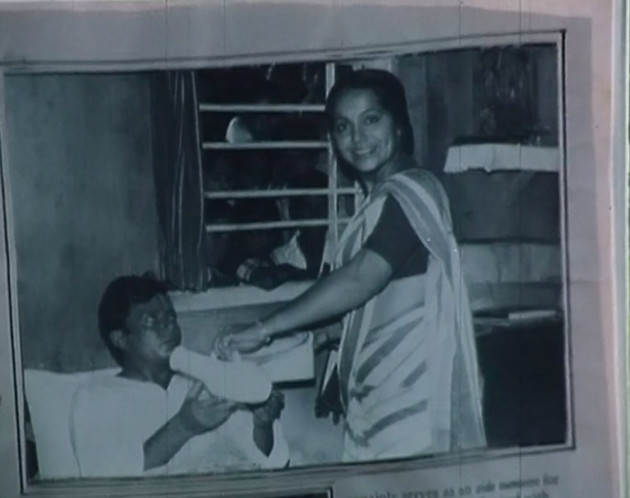
A social worker hired by Shivalik poses with the injured, bedridden Chote Lal, donating a urinal as an ”offering” from the company, 1:06:37 (Photo source, Neo Films Association)
In contesting this false image at a workers’ rally, Verma speaks about the unreliability and violence of this manufactured image as well as the importance of seeing past propaganda of this sort to be a rational comrade in the movement. The film’s final scene shows Verma, along with his mentor, recalling the events that went wrong. He feels clueless about how to proceed. In his signature style of one-on-one conversations, Nihalani places them at a comfortable distance from one another in the setting. Between failing or giving into opportunism, Verma is offered a third choice – which he ambiguously extends in a monologue, in the form of a personal discovery, alone, in a short, dimly-lit alley.
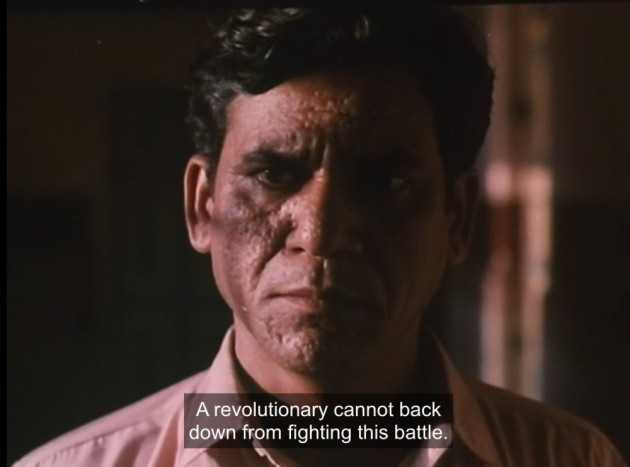
Verma reflects on his poor decisions and the way forward for the workers’ struggle, 2:15:39 (Photo source, Neo Films Association)
Despite Verna’s final, solitary redemption, Aghaat never feels like a film about Madhav Verma; it remains a film primarily about the workers of Bombay. Aghaat is an excellent film whose importance has not been recognized, and should be seen as a response to the rhetoric of Congress Party socialism and the war against the working class, which is why it remains relevant. By focusing on industrial relations and subaltern crime through its nuanced narrative, it reveals the broader system that sustains and extols anti-worker policies.
In 2020, India’s central government passed a new Industrial Relations Code, which will replace three laws, the Industrial Disputes Act (1947), the Trade Union Act (1926), and the Industrial Employment (Standing Orders) Act (1946). The new labour codes do away with several worker protections, and have “been brought into effect only to promote profit maximization for capitalists at the cost of workers’ and employees’ fundamental rights and dignity. These laws will ensure that the workers are exploited exponentially and pushed towards an uncertain, precarious and hopeless future.” 10 Anti-worker policies and corporate consolidation are what our current neoliberal order is premised on. Therefore, drawing comparisons between the society presented in Aghaat and contemporary India offers an obvious and compelling analytic framework. Aghaat is a film of its time, succinctly chronicling the gradual disintegration of union power, but it also points to future possibilities that face us today. Despite the technology currently available, there is still a lack of depictions in popular media of the worsening conditions of workers. In a time of consolidation of the state-corporate nexus, a new portrait of worker issues in the manner of Aghaat would be welcome .
Notes
- Rochona Majumdar. Art Cinema and India’s Forgotten Futures: Film and History in the Postcolony. New York, NY: Columbia University Press, 2021, 3. ↩
- John W. Hood. The Essential Mystery: Major Filmmakers of Indian Art Cinema. Hyderabad, IN: Orient Longman, 2000, 314. ↩
- Ravi Vasudevan. The Melodramatic Public, Ranikhet, IN: Permanent Black, 2010, 313. ↩
- B.T. Ranadive on the Trade Union Movement, (Presidential Address, 3rd Conference of CITU, Bombay, May, 1975. ↩
- Film Finance Corporation, India’s state funding body for films at the time. ↩
- Vasudevan, 313 ↩
- Jacques Rancière. “Aesthetic Separation, Aesthetic Community: Scenes from the Aesthetic Regime of Art.” Art & Research: A Journal of Ideas, Contexts and Methods 2, no. 1. (Summer, 2008): 4. ↩
- Ashok Bhargava and Gopalan Balachandran. “Economic Changes During the Indian Emergency.” Bulletin of Concerned Asian Scholars. 9, no. 4. (1977): 54, DOI: 10.1080/14672715.1977.10406432 ↩
- Vijay Prasad. No Free Left: The Futures of Indian Communism, New Delhi: LeftWord Books, 2015. ↩
- Tech People, AIITEU, March 2022. ↩






